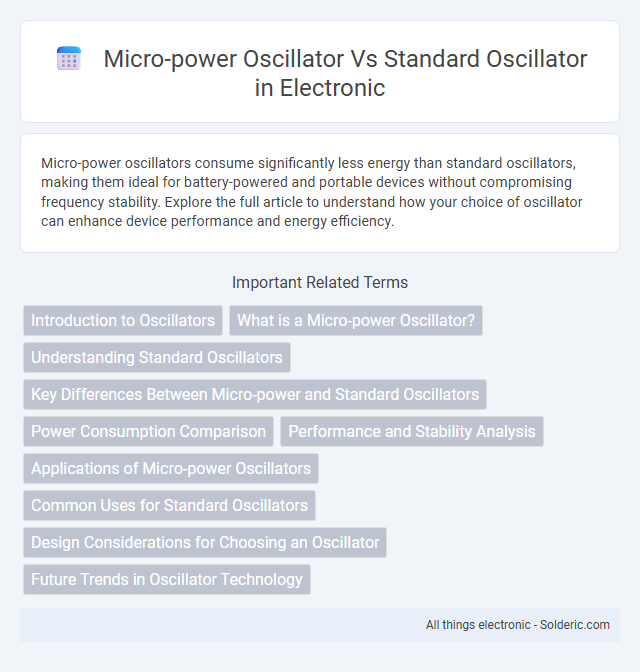Micro-power oscillators consume significantly less energy than standard oscillators, making them ideal for battery-powered and portable devices without compromising frequency stability. Explore the full article to understand how your choice of oscillator can enhance device performance and energy efficiency.
Comparison Table
| Feature | Micro-Power Oscillator | Standard Oscillator |
|---|---|---|
| Power Consumption | Ultra-low power, typically in microwatts | Moderate power, typically in milliwatts |
| Frequency Range | Low to moderate frequency (kHz to low MHz) | Wide frequency range (kHz to GHz) |
| Application | Battery-powered devices, IoT sensors, wearables | General purpose electronics, communication systems |
| Size | Compact, optimized for integration | Standard sizes, may require additional components |
| Cost | Higher per unit due to low-power design | Lower per unit due to mass production |
| Stability | Moderate; optimized for low power over precision | High stability and precision |
| Startup Time | Faster startup optimized for energy saving | Standard startup time |
Introduction to Oscillators
Micro-power oscillators consume significantly less energy than standard oscillators, making them ideal for battery-operated and energy-sensitive applications like wearable devices and IoT sensors. Standard oscillators typically offer higher frequency stability and accuracy, which is essential for communication systems and precision timing. Your choice depends on balancing power efficiency with performance requirements specific to the application.
What is a Micro-power Oscillator?
A Micro-power Oscillator is an electronic circuit designed to operate at extremely low power consumption, making it ideal for battery-powered and portable devices. Unlike standard oscillators that prioritize frequency stability and signal integrity often at higher power levels, micro-power oscillators balance energy efficiency with adequate performance for timing and waveform generation. Your choice of a micro-power oscillator ensures extended battery life and minimal energy use in applications such as wearable electronics, IoT sensors, and low-power communication systems.
Understanding Standard Oscillators
Standard oscillators are electronic circuits used to generate continuous, regular waveforms, typically sine or square waves, with stable frequency and amplitude for timing applications. They often rely on quartz crystal or LC circuits to maintain frequency precision in communication and signal processing devices. Standard oscillators provide reliable performance but generally consume more power compared to micro-power oscillators used in energy-efficient or portable systems.
Key Differences Between Micro-power and Standard Oscillators
Micro-power oscillators consume significantly less current, often in the microampere range, making them ideal for battery-operated and low-energy devices, whereas standard oscillators draw higher current suitable for applications demanding consistent, high-frequency signals. The frequency stability and output drive capability of standard oscillators generally surpass that of micro-power oscillators, benefiting complex communication and timing systems. Micro-power oscillators prioritize energy efficiency and compact size, while standard oscillators emphasize performance and robustness in industrial and consumer electronics.
Power Consumption Comparison
Micro-power oscillators consume significantly less power than standard oscillators, making them ideal for battery-operated and energy-sensitive applications. Standard oscillators typically draw higher currents, which can lead to increased energy costs and reduced device lifespan. Your choice of micro-power oscillator can extend operational time in portable electronics by minimizing power consumption without sacrificing performance.
Performance and Stability Analysis
Micro-power oscillators deliver superior power efficiency with minimal energy consumption, making them ideal for battery-powered and portable applications. Standard oscillators typically offer higher signal amplitude and frequency stability, benefiting precision-demanding environments but at the cost of increased power usage. Stability analysis reveals that micro-power oscillators may exhibit higher phase noise and temperature sensitivity, whereas standard oscillators maintain consistent performance across varying environmental conditions.
Applications of Micro-power Oscillators
Micro-power oscillators are essential in battery-operated and portable electronic devices due to their ultra-low power consumption, enabling extended battery life in applications such as wearable health monitors, wireless sensor networks, and IoT devices. These oscillators provide stable frequency generation with minimal power usage, making them ideal for energy-sensitive environments like biomedical implants and remote environmental monitoring systems. Their integration into microcontroller circuits supports efficient clocking and timing functions without significantly draining power resources.
Common Uses for Standard Oscillators
Standard oscillators are widely used in communication systems, signal processing, and timing applications due to their stable frequency output and high precision. They play a critical role in clocks, radios, and electronic test equipment where consistent signal generation is essential. Your choice of a standard oscillator ensures reliable performance in complex electronic circuits requiring accurate timing references.
Design Considerations for Choosing an Oscillator
Design considerations for choosing between a micro-power oscillator and a standard oscillator include power consumption, frequency stability, and application-specific requirements. Micro-power oscillators are ideal for battery-operated devices due to their low energy usage and extended battery life, while standard oscillators offer higher frequency accuracy and stability suited for precision applications. Factors such as operating voltage, temperature range, and phase noise levels must also be evaluated to ensure optimal performance in the intended electronic circuit.
Future Trends in Oscillator Technology
Micro-power oscillators are set to dominate future trends in oscillator technology due to their ultra-low power consumption, making them ideal for IoT devices and wearable electronics requiring energy efficiency. Standard oscillators, while reliable and widely used, may face phasing out in applications demanding miniaturization and extended battery life, where micro-power variants provide comparable stability and frequency precision. Advances in semiconductor materials and MEMS technology will further enhance the integration and performance of micro-power oscillators, driving innovation in low-power, high-frequency timing solutions.
Micro-power oscillator vs Standard oscillator Infographic

 solderic.com
solderic.com